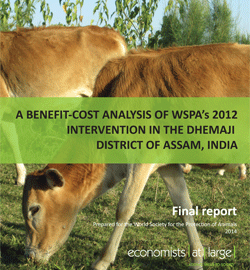A benefit-cost analysis of WSPA’s 2012 intervention in the Dhemaji District of Assam, India
-
Year Published: 2013
Author/s: Tristan Knowles, Roderick Campbell
Commissioned by: World Animal Protection
Suggested citation:
Economists at Large, 2014, A Benefit-cost analysis of WSPA’s 2012 Intervention in the Dhemaji district of Assam, India. A report for The World Society for the Protection of Animals, prepared by Economists at Large, Melbourne, Australia
Download Publication
- WSPA’s short-term response (STR) to the 2012 Assam floods protected livestock production worth USD$4.7 million.
- Costing only USD$49,000, the STR provided very high returns at low cost.
- Net benefit and benefit cost ratio calculations depend on the percentage of livestock value actually attributable to the response, which is uncertain.
- At a rate of 100%:
- Net benefits of USD$4,690,986
- Benefit-cost ratio of 96
- At a rate of 50%, highly likely based on interviews with beneficiaries:
- Net benefits of USD$2,320,831
- Benefit-cost ratio of 48
- To break even in economic terms, the response only needed to assist 1% of livestock production. Based on interview responses this was easily exceeded.
- Protecting livestock in the immediate aftermath of a natural disaster provides such high economic returns as it directly assists the livelihoods and existing productive assets of local people.

